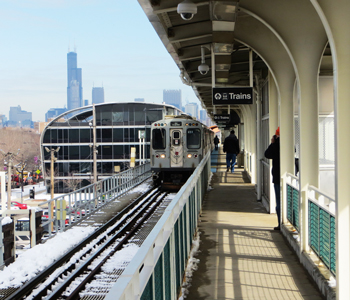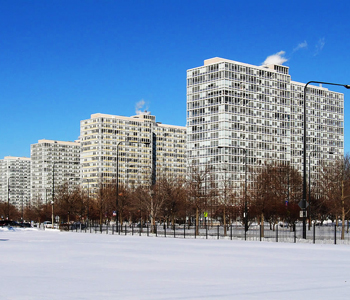UPDATE, Aug. 2, 11:50 a.m.: Hasani Steele leaned back in his office chair and used his mouse to swoop Google Earth over the 400 block of East 41st Street on his 55-inch monitor. He zoomed in on the houses his company just built, each unit costing around $700,000.
“Around here, this is where all the millionaires used to live,” said Steele, CEO of Steele Consulting Group, as the screen moved across the grassy thoroughfares that gave the Grand Boulevard area its name. Stretching back to the 1893 World’s Columbian Exposition in Jackson Park, the South Side — including Bronzeville — was where the city’s well-to-do lived, decades before money shifted to more tightly-packed development in Lincoln Park and Lakeview.
But Steele, whose firm has built, marketed or rehabbed dozens of residential projects across the South Side since 2004, said whenever he sells a property, “we always have to make an appraisal packet an inch thick. A lot of times [appraisers] are going to hit it low, because they just don’t understand everything the area has going for it.”
After decades of economic trials, signs are emerging that Bronzeville’s lakefront access, proximity to Downtown and rich cultural history have begun to draw new residents and developers. Now, as skyscrapers climb in the nearby South Loop and a trio of Near South Side mega-developments comes into focus, the area is getting harder to ignore.
McCaffrey Interests and The Community Builders got the Chicago Plan Commission’s go-ahead last month for their nearly 1,000-unit redevelopment of the former Harold L. Ickes homes, which would knock on Bronzeville’s door just across the Stevenson Expressway when the first phase is built next year.

The recently-completed 35th Street Green Line station (Credit: David Wilson via Flickr)
Looking further into the future, a coalition of companies led by Farpoint Development is negotiating with city planners to buy the 100-acre former site of Michael Reese Hospital on the neighborhood’s northeast corner, where Farpoint envisions high-tech offices and retail clustered around a “life science campus” with “biomedical and genomic research space,” according to development director Elle Ramel.
And McLaurin Development, one of Farpoint’s partners on the Michael Reese site, is also in talks with the city to build hundreds of homes on a 20-acre property overlapping the footprint of the demolished Stateway Gardens public housing complex near the corner of 39th and State streets.
Principals at Farpoint and McLaurin say they’re focused on building out the neighborhood’s retail options, which today are dwarfed by busy commercial corridors in the South Loop and Hyde Park.
Home values in Bronzeville are already catching up to wealthier neighborhoods, plodding a steady recovery since the Near South Side took an outsized blow from the recession. Bronzeville’s median home sale price climbed by 54 percent over three years to reach $218,000 in June, according to Redfin. The citywide median grew by just 10 percent during the same period, ending at $302,000.
And builders have just recently started launching more projects in Bronzeville. The city granted 73 permits for new construction totalling almost $30 million of work in the neighborhood between July 2017 and July 2018, compared to 27 permits for $19 million worth of projects — including a $11 million park fieldhouse reconstruction — during the same period from 2014-15.
Earlier this year, the first round of single-family houses was completed through the city’s Parade of Homes program, which gives developers discounts on city-owned land to build market-rate homes. And they turned brokers’ heads when they sold for upward of $600,000 each in the 4500 block of South Prairie Avenue.
And apartment buildings are selling in Bronzeville at values that would have been “unheard of” just two years ago, according to Noah Birk, senior director of the brokerage Kiser Group. Birk routinely markets buildings in Bronzeville with 6 percent capitalization rates, down from 10 or 12 percent in 2016, signaling heightened competition over properties from out-of-state buyers, he said.
Real estate investors typically either seek high-risk projects where they can reap big gains, or safe bets where they can let their money appreciate over time. Bronzeville is the rare corner of the city that offers both opportunities, Birk said.
“Bronzeville happens to be at the northern part of the area where you can get the most cash flow, but properties have also appreciated so rapidly that [investors] feel like they can park their money safely,” Birk said. “It’s unique, historically speaking, to have a place like that where you can get the best of both worlds.”
During the mid-20th century, the Bronzeville historic district was known as the “Black Metropolis,” whose 47th Street retail corridor rivaled Harlem’s 125th Street. But the area suffered steep population loss starting in the 1950s, when city urban renewal programs demolished vast tracts of homes in favor of new parks and shopping centers. The Chicago Housing Authority’s demolition of large complexes like Stateway Gardens and the Robert Taylor Homes in the early 2000s accelerated that trend, scattering tens of thousands of mostly young residents.
The Near South Side was also hit especially hard by the foreclosure crisis compared to the rest of the city, following heavy investment in the area during the subprime housing bubble. Home prices around Bronzeville and Hyde Park were still about 32 percent lower on average in the fourth quarter of 2017 than they were at their 2008 peak, according to a report from DePaul University’s Institute for Housing Studies.
One of the goals of the Michael Reese redevelopment, now being advertised as the Burnham Lakefront, will be to restore some of the retail and commercial bustle that the area used to be known for, Farpoint’s Ramel said.
“Right now, if you’re walking through the South Loop and you get to McCormick Place, it becomes so hard to navigate that most people just tend to stop,” Ramel said. “So part of the challenge will be creating an anchor that can drive people south … and create more of a neighborhood space.”
Ramel noted a heavy imbalance between residential and commercial properties in the area. She cited a finding in Natalie Moore’s 2016 book, “The South Side,” that Bronzeville sees about $150 million in annual “retail leakage,” which refers to money residents spend in other neighborhoods.
“A lot of black young professionals who live in the South Loop or Hyde Park tell me they’d love to be able to get a home in Bronzeville, but they want to have a place to eat, or walk, or experience entertainment,” Ramel said. “Of course, there are some wonderful places to go, but there just isn’t a contiguous corridor between 22nd Street and 47th Street that … looks like Clark Street or Archer Avenue.”
Harbingers of gentrification have already begun sprouting around Douglas, the community at the northern end of Bronzeville. A 74,000-square-foot Mariano’s supermarket opened at King Drive and Pershing Road in 2016, the same year Baderbräu gave the neighborhood its first microbrewery. And earlier this year, Culver’s restaurant chose the Lake Meadows Shopping Center at 35th and State streets for its first Chicago location.
The signs are encouraging for Zeb McLaurin, whose proposed PS Bronzeville mixed-use development would open hundreds of new apartments with retail and outdoor spaces just across the Dan Ryan Expressway from Guaranteed Rate Field.

The Prairie Shores residences in Douglas (Credit: Wikipedia)
“You’re seeing a natural progression from the north and east, coming down King Drive with all its stately mansions, which is really the backbone of the community,” McLaurin said. “If you look at 35th and King and 39th and King as major nodes of that progression, we think 39th and State is hopefully the next natural step.”
McLaurin’s site also includes a quarter-mile of decommissioned rail line, which the developer hopes to springboard into the city’s next major “rails-to-trail” project, like the popular 606 trail on the North Side. The pedestrian-and-bike path could eventually reach all the way to the lake, McLaurin said.
To be sure, this isn’t the first time a growing crowd of buyers has looked to Bronzeville for opportunities. The area saw heavy speculative investment during the mid-2000s, when then-mayor Richard M. Daley was grooming the Michael Reese Hospital site as a potential Olympic Village for the 2016 Summer Olympics. When that bid failed, plans changed.
Today, Steele said the neighborhood’s market is on steadier ground. Most of his prospective buyers are middle-class city residents looking for primary homes, not out-of-town investors scooping up extra assets, he said.
“Often with the South Side, there can be this attitude where everyone suddenly says ‘OK, it’s starting now,’” Steele said. “But these neighborhoods have already been established for a long time. I think some people are just starting to recognize them.”
The first paragraph of this story has been corrected to reflect the homes developed by Hasani Steele’s company were single-family houses.
